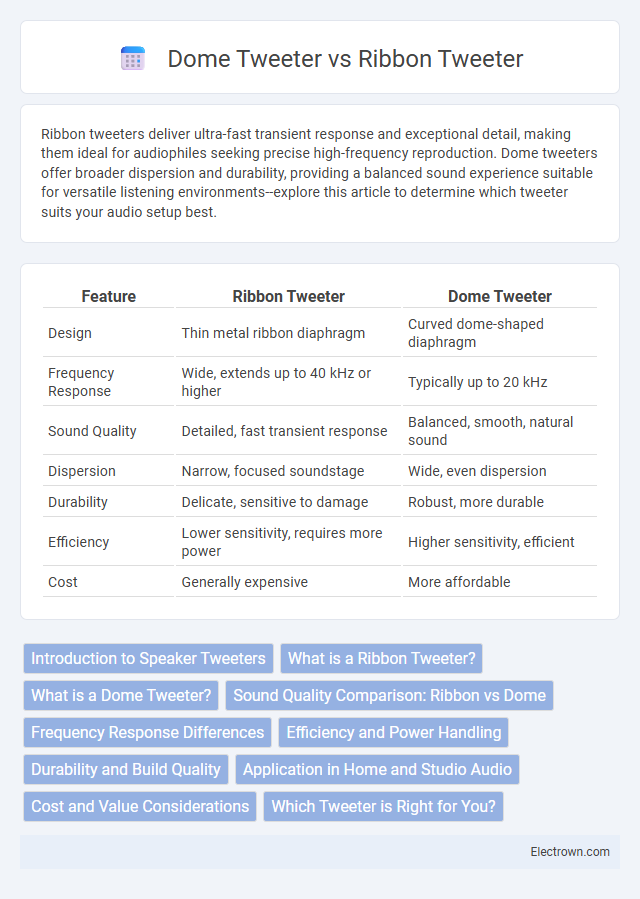Ribbon tweeters deliver ultra-fast transient response and exceptional detail, making them ideal for audiophiles seeking precise high-frequency reproduction. Dome tweeters offer broader dispersion and durability, providing a balanced sound experience suitable for versatile listening environments--explore this article to determine which tweeter suits your audio setup best.
Table of Comparison
| Feature | Ribbon Tweeter | Dome Tweeter |
|---|---|---|
| Design | Thin metal ribbon diaphragm | Curved dome-shaped diaphragm |
| Frequency Response | Wide, extends up to 40 kHz or higher | Typically up to 20 kHz |
| Sound Quality | Detailed, fast transient response | Balanced, smooth, natural sound |
| Dispersion | Narrow, focused soundstage | Wide, even dispersion |
| Durability | Delicate, sensitive to damage | Robust, more durable |
| Efficiency | Lower sensitivity, requires more power | Higher sensitivity, efficient |
| Cost | Generally expensive | More affordable |
Introduction to Speaker Tweeters
Ribbon tweeters deliver precise high-frequency sounds using thin metal ribbons that respond rapidly to audio signals, offering exceptional clarity and detail. Dome tweeters, commonly made from fabric or metal domes, provide smooth, wide dispersion of high frequencies, enhancing the overall listening experience in various environments. Your choice between ribbon and dome tweeters influences sound accuracy, dispersion, and the tonal character of your speaker system.
What is a Ribbon Tweeter?
A ribbon tweeter uses a thin aluminum or other metal ribbon suspended in a magnetic field to produce high-frequency sound with exceptional detail and clarity. Unlike dome tweeters that rely on a dome-shaped diaphragm, ribbon tweeters have lower mass, allowing for faster response times and extended high-frequency range. If your audio system demands precision and transparency, a ribbon tweeter can enhance your listening experience by delivering crisp and accurate treble.
What is a Dome Tweeter?
A dome tweeter is a type of high-frequency driver commonly used in speakers, characterized by a dome-shaped diaphragm usually made from materials like silk, aluminum, or titanium. It delivers smooth, accurate sound reproduction with wide dispersion, enhancing audio clarity and detail in your listening experience. Compared to ribbon tweeters, dome tweeters offer greater versatility in mounting and durability, making them a popular choice for a variety of audio systems.
Sound Quality Comparison: Ribbon vs Dome
Ribbon tweeters deliver exceptionally clear and detailed high frequencies due to their lightweight diaphragm and fast transient response, producing a more natural and airy soundstage. Dome tweeters offer a smoother and warmer treble with broader dispersion, making them ideal for versatile listening environments. Your choice depends on whether you prioritize accuracy and detail or a more relaxed and wide sound distribution.
Frequency Response Differences
Ribbon tweeters typically offer a wider frequency response, extending smoothly into the higher ranges above 40 kHz, delivering crisp and detailed treble. Dome tweeters usually have a more limited upper frequency range, often maxing out around 20 kHz to 30 kHz, providing balanced and warm sound reproduction. The broader frequency response of ribbon tweeters makes them ideal for audiophiles seeking exceptional high-frequency clarity and resolution.
Efficiency and Power Handling
Ribbon tweeters typically offer higher efficiency due to their lightweight diaphragm, enabling better responsiveness to audio signals with less amplifier power. Dome tweeters often excel in power handling, tolerating higher wattage levels without distortion, making them suitable for louder sound environments. Your choice depends on whether you prioritize precise, efficient sound reproduction or robust power endurance for your audio setup.
Durability and Build Quality
Ribbon tweeters feature a thin, lightweight aluminum ribbon diaphragm that offers excellent transient response but can be more fragile and susceptible to damage from dust and moisture. Dome tweeters typically use a robust fabric or metal dome construction that provides greater durability and longevity in various environmental conditions. When considering durability and build quality, your choice depends on whether you prioritize delicate sound precision or rugged reliability.
Application in Home and Studio Audio
Ribbon tweeters deliver exceptionally detailed high-frequency response, making them ideal for critical listening environments like professional studios where accuracy is paramount. Dome tweeters offer a broader dispersion pattern and smooth tonal balance, enhancing home audio systems by providing a more immersive and natural soundstage. Both tweeter types improve audio fidelity, but ribbon tweeters prioritize precision, while dome tweeters excel in versatile, room-friendly performance.
Cost and Value Considerations
Ribbon tweeters generally come at a higher cost due to their complex manufacturing process and superior high-frequency response, offering exceptional sound clarity and detail. Dome tweeters provide a more budget-friendly option while still delivering reliable performance and versatility across different audio setups. Your choice should balance budget constraints with the desired audio fidelity, ensuring optimal value for your sound system.
Which Tweeter is Right for You?
Choosing between ribbon and dome tweeters depends on your listening preferences and audio setup. Ribbon tweeters deliver exceptionally detailed, transparent high frequencies with ultra-fast transient response, ideal for audiophiles seeking clarity and precision in critical listening environments. Dome tweeters offer a balanced, smooth sound with wider dispersion and greater durability, making them suitable for versatile home audio systems and everyday use.
ribbon vs dome tweeter Infographic

 electrown.com
electrown.com